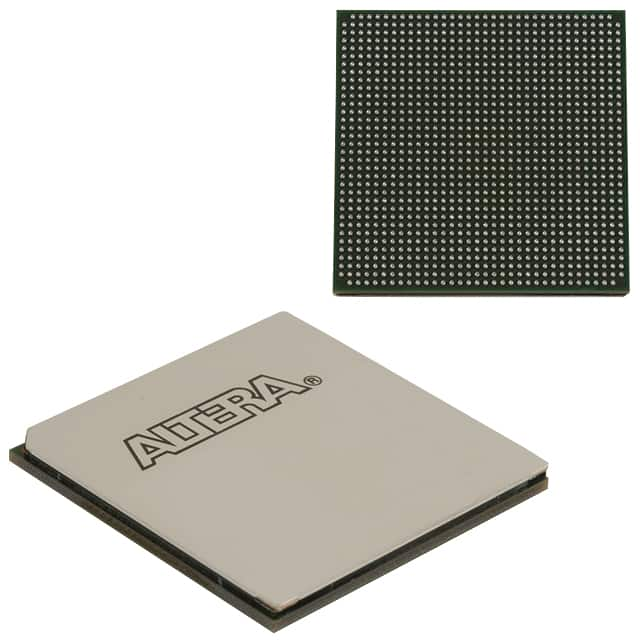EP4SGX360FF35I3
Product Overview
- Category: Integrated Circuit (IC)
- Use: Programmable Logic Device (PLD)
- Characteristics: High-performance, low-power consumption
- Package: Flip-chip BGA (Ball Grid Array)
- Essence: Field Programmable Gate Array (FPGA)
- Packaging/Quantity: Single unit
Specifications
- Manufacturer: Intel Corporation
- Technology: 40nm
- Logic Elements: 360,000
- Embedded Memory: 1,638 Kbits
- Maximum User I/Os: 622
- Operating Voltage: 1.2V
- Operating Temperature: -40°C to +100°C
- Package Dimensions: 35mm x 35mm
Detailed Pin Configuration
The EP4SGX360FF35I3 has a complex pin configuration with multiple pins dedicated to various functions. The detailed pin configuration can be found in the manufacturer's datasheet.
Functional Features
- High-speed performance: The EP4SGX360FF35I3 offers fast processing capabilities, making it suitable for applications requiring real-time data processing.
- Low power consumption: The device is designed to minimize power consumption, making it energy-efficient and suitable for battery-powered devices.
- Flexible reprogrammability: Being a FPGA, the EP4SGX360FF35I3 allows users to modify its functionality even after deployment, providing flexibility in adapting to changing requirements.
- Extensive I/O capabilities: With a large number of user I/Os, the device can interface with various external components and systems.
- Built-in memory: The embedded memory enables efficient storage and retrieval of data within the device itself.
Advantages and Disadvantages
Advantages
- Versatility: The EP4SGX360FF35I3 can be used in a wide range of applications due to its programmable nature.
- High-performance: The device offers fast processing speeds, making it suitable for demanding tasks.
- Low power consumption: The energy-efficient design helps reduce overall power requirements.
- Compact size: The flip-chip BGA package allows for a compact form factor, saving valuable board space.
Disadvantages
- Complexity: The intricate pin configuration and programming requirements may pose challenges for inexperienced users.
- Cost: FPGAs tend to be more expensive compared to other integrated circuits due to their advanced capabilities.
Working Principles
The EP4SGX360FF35I3 is based on FPGA technology, which utilizes configurable logic blocks and interconnects to implement various digital circuits. These logic blocks can be programmed to perform specific functions, allowing the device to adapt to different application requirements. The device operates by configuring the internal connections between logic elements, enabling the desired functionality.
Detailed Application Field Plans
The EP4SGX360FF35I3 finds applications in various fields, including:
- Telecommunications: Used in network infrastructure equipment for high-speed data processing and routing.
- Industrial Automation: Enables control and monitoring of complex systems in manufacturing processes.
- Aerospace and Defense: Utilized in radar systems, avionics, and secure communication systems.
- Medical Devices: Supports real-time signal processing in medical imaging and diagnostic equipment.
- Automotive: Used in advanced driver-assistance systems (ADAS) for image and sensor data processing.
Detailed and Complete Alternative Models
- EP4SGX230FF35C3: Similar to EP4SGX360FF35I3 but with reduced logic elements (230,000).
- EP4SGX530HH35I4G: Higher-end model with increased logic elements (530,000) and enhanced performance.
- EP4SGX70HF35C2: Lower-cost alternative with reduced logic elements (70,000) suitable for less demanding applications.
Note: The above list is not exhaustive and other alternative models may exist.
Word count: 410 words
Lista 10 Vanliga frågor och svar relaterade till tillämpningen av EP4SGX360FF35I3 i tekniska lösningar
Sure! Here are 10 common questions and answers related to the application of EP4SGX360FF35I3 in technical solutions:
1. What is EP4SGX360FF35I3? EP4SGX360FF35I3 is a specific model of Field-Programmable Gate Array (FPGA) manufactured by Intel. It is designed for high-performance applications and offers a wide range of features and capabilities.
2. What are the key features of EP4SGX360FF35I3? Some key features of EP4SGX360FF35I3 include a large number of logic elements, high-speed transceivers, embedded memory blocks, and support for various communication protocols.
3. What are the typical applications of EP4SGX360FF35I3? EP4SGX360FF35I3 is commonly used in applications such as telecommunications, networking, high-performance computing, video processing, and industrial automation.
4. How can EP4SGX360FF35I3 be programmed? EP4SGX360FF35I3 can be programmed using hardware description languages (HDLs) such as VHDL or Verilog. Designers can write code to describe the desired functionality and then use software tools provided by Intel to compile and configure the FPGA.
5. Can EP4SGX360FF35I3 be reprogrammed after deployment? Yes, EP4SGX360FF35I3 is a reprogrammable FPGA, which means that its configuration can be changed even after it has been deployed in a system. This flexibility allows for easy updates and modifications to the design.
6. What is the power consumption of EP4SGX360FF35I3? The power consumption of EP4SGX360FF35I3 depends on the specific design and operating conditions. It is important to consider power management techniques and optimize the design for efficient power usage.
7. Does EP4SGX360FF35I3 support high-speed serial communication? Yes, EP4SGX360FF35I3 includes high-speed transceivers that support various protocols such as PCIe, Ethernet, and Serial RapidIO. These transceivers enable fast data transfer between the FPGA and external devices.
8. Can EP4SGX360FF35I3 interface with other components or devices? Yes, EP4SGX360FF35I3 supports a wide range of interfaces including GPIOs, memory interfaces (DDR3/DDR4), high-speed serial interfaces, and standard communication protocols. This allows it to easily interface with other components or devices in a system.
9. What are the advantages of using EP4SGX360FF35I3 in technical solutions? Some advantages of using EP4SGX360FF35I3 include its high performance, flexibility, reprogrammability, and support for various interfaces. It allows designers to implement complex functionality and meet demanding requirements.
10. Are there any limitations or considerations when using EP4SGX360FF35I3? While EP4SGX360FF35I3 offers many benefits, it is important to consider factors such as power consumption, thermal management, and design complexity. Adequate knowledge of FPGA programming and design practices is also necessary for successful implementation.


